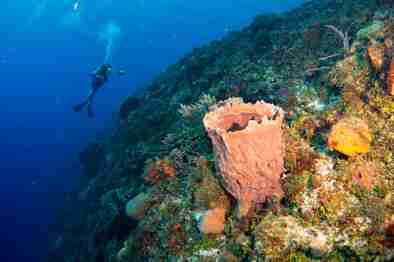In the deep, mysterious waters of our oceans, there exists an organism so ancient and unique that it has remained relatively unchanged for millions of years. Sea sponges—simple yet fascinating creatures—are the epitome of life’s ability to adapt and thrive in the most unusual ways. They may lack the complex structures of many marine organisms, but their survival and ecological role are essential. From their intriguing feeding mechanisms to the secrets of their reproduction, the world of sea sponges is full of hidden wonders.
Sea Sponges: Ancient and Simple Organisms
Sea sponges belong to the sea sponge phylum Porifera, which means “pore-bearer” in Latin, aptly named due to the numerous pores that cover their bodies. These animals are among the oldest living creatures on Earth, with fossil records dating back over 600 million years. Their bodies are not made up of tissues or organs like more complex animals, but are instead a loose collection of specialized cells. These cells work together to allow the sponge to filter-feed, reproduce, and perform other vital functions, despite their simplicity.
How Sea Sponges Feed: Nature’s Filtration System –what does sea sponge eat?
One of the most remarkable aspects of sea sponges is their feeding process. Unlike most animals that ingest food through a mouth, sponges are filter feeders, constantly drawing water into their bodies through tiny pores called ostia. The water then passes through a network of canals and chambers, where specialized cells called choanocytes (collar cells) capture and ingest tiny particles such as plankton, bacteria, and organic matter suspended in the water.
The sponge’s ability to filter large volumes of water—sometimes up to 20,000 times their body volume per day—helps keep the surrounding waters clean and clear, benefiting other marine organisms. This feeding method also means that sponges do not need to move in search of food; the constant flow of water through their bodies provides all the nutrients they need.
How Sea Sponges Move: The Art of Stillness
Unlike most marine creatures, sea sponges do not move in the traditional sense. They are sessile organisms, meaning they remain fixed in one location throughout their lives. Sponges can attach to rocks, coral, or the seafloor using a specialized structure called the basal disc. While adult sponges are immobile, they can, however, move in a subtle way at the microscopic level.
Larvae, which are the young stage of a sponge, are free-swimming and capable of moving through the water column in search of a suitable place to settle and grow into an adult sponge. Once they find the right environment, they attach themselves to a surface and begin their growth into a stationary, filter-feeding adult.
Reproduction in Sea Sponges: A Dual Approach
Sea sponges have developed a fascinating and adaptable method of reproduction. They can reproduce both sexually and asexually, ensuring their survival across a range of environments.
Asexual Reproduction: This occurs through a process called budding or fragmentation. When a sponge is physically damaged or a piece of it breaks off, the broken section can regenerate into a fully functioning new sponge. Some sponges can also produce specialized structures called gemmules—small, hardy clusters of cells that can survive harsh conditions and develop into new sponges when favorable conditions return.
Sexual Reproduction: Sponges can also reproduce sexually by releasing sperm into the water. Most species are hermaphroditic, meaning they have both male and female reproductive organs. Sperm from one sponge is carried by the water to another sponge, where it fertilizes the eggs internally. The fertilized eggs develop into larvae, which are then released into the water. These larvae are free-swimming and, after a brief period, will settle onto a surface to grow into a new adult sponge.
Interestingly, some species of sea sponges have a unique strategy of internal fertilization. The eggs are kept within the sponge until they are fertilized by sperm from another sponge. This strategy ensures that sponges can reproduce even in environments with sparse or unpredictable sperm flow.
The Role of Sea Sponges in Marine Ecosystems
Despite their simple structure, sea sponges play a crucial role in marine ecosystems. They serve as vital filters, helping to maintain water quality and clarity by removing plankton, bacteria, and other organic particles from the water. This filtering process benefits not only the sponge itself but also the surrounding organisms by creating a healthier environment.
Sponges are also essential habitats for a variety of marine species, including small fish, crustaceans, and other invertebrates. These creatures often take refuge inside the sponge’s porous body, using it as a safe shelter from predators. Additionally, sponges provide food for certain species, contributing to the overall biodiversity of the marine ecosystem.
Conclusion: The Quiet Strength of Sea Sponges
Sea sponges are silent yet powerful forces in the ocean. Their feeding mechanisms, reproduction strategies, and ability to survive in a wide range of environments make them some of the most fascinating creatures in the marine world. While they may appear simple, sea sponges are key players in the health of marine ecosystems, supporting both biodiversity and water quality.
Their remarkable adaptability, from filtering the ocean to regenerating and reproducing in diverse ways, shows that life doesn’t always need complexity to thrive. Instead, sometimes the quiet, unassuming organisms are the ones that play the most vital roles, ensuring the balance of life in the sea for millions of years to come.
